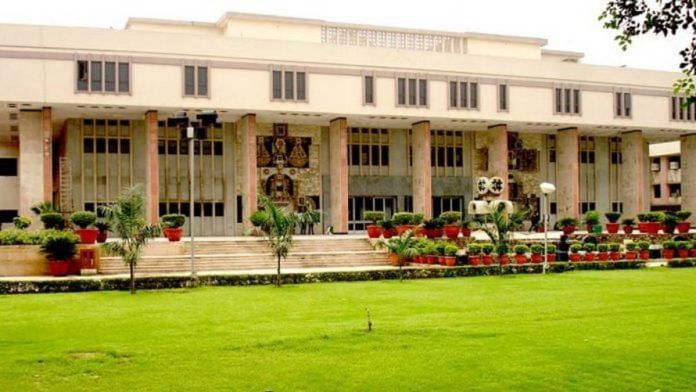New Delhi: While traditional tattoos on the left inner forearm are permitted in the Central Armed Police Forces (CAPF), a tattoo on the right forearm—the saluting arm—is strictly barred as it disrupts uniformity, discipline and the visual neutrality expected of a soldier, the Ministry of Home Affairs (MHA) has told the Delhi High Court.
Defending the rejection of a CRPF candidate who cleared every stage of recruitment except the medical test, the MHA said “the present young generation is considerably under the influence of western culture” and engraving of skin art—which is “distasteful” and distracting inside a disciplined force.
In its reply before the Delhi High Court, the MHA said the policy on tattoos is rooted in discipline, uniformity and secular neutrality within the Central Armed Police Forces, and leaves “no provision” for a third or fresh medical examination once a candidate is found unfit in both the Detailed Medical Examination (DME) and Review Medical Examination (RME).
The Delhi High Court heard the matter on Monday and listed it for disposal on 24 November. On October 29—the previous date of hearing—a bench of Justices C. Hari Shankar and Om Prakash Shukla recorded that they “do not understand how the mere presence of a tattoo on the right forearm of a candidate can disqualify him for recruitment to the forces” and asked the Indian government whether such a guideline “is at all sustainable in law”.
MHA: Tattoos affect uniformity, saluting protocol
In its counter affidavit, which the court recorded, the MHA said the rejection was fully in line with MHA guidelines from 2015.
The explanatory note quoted: “Tattoo: The practice of engraving/tattooing in India is prevalent since time immemorial, but has been limited to depict the name or a religious figure, invariably on inner aspect of forearm and usually on left side. On the other hand, the present young generation is considerably under the influence of western culture and thus the number of potential recruits bearing skin art had grown enormously over the years, which is not only distasteful but distract from good order and discipline in the force.”
The core of the MHA’s position emphasises neutrality: “The forces are strictly secular. Tatoos that depict religious, political or sectarian symbols are seen as incompatible with the ethos of neutrality and unity of the force. Hence visible tattoos with religious or political connotations are not permitted, especially on exposed part like hand or arms.”
The ministry stressed that visible tattoos on the right arm—the saluting arm—undermine uniformity: “The CAPF place a very high value on discipline, uniformity and team identity. Tattoos on visible body parts (especially right hand which is used to salute the seniors as a mark of greeting) are seen as affecting this sense of uniformity.”
“In uniform, every soldier is expected to appear identical and professional with no personal markings that stand out. Tattoos being a personal expression can detract from that collective identity/uniformity.”
Tattoos, the MHA added, “may mask underlying skin conditions, making medical examination difficult” and “may reveal personal, regional or religious affiliations which could compromise operational security or neutrality in sensitive posting”.
Permissible tattoos, according to the policy, are limited to religious symbols, figures or names, placed only on “traditional sites” such as the inner aspect of the left forearm or the dorsum of the hands, and must be “less than ¼ of the particular part (elbow or hand) of the body”.
Petition challenges strict tattoo rule as arbitrary
The petitioner, Vipin Kumar, filed a writ under Articles 226 and 227 seeking to quash the ‘medically unfit’ report dated 18 July 2024 and requesting a fresh medical examination.
Kumar had applied for the post of Constable (motor mechanic vehicle) under the CRPF recruitment advertised on 15 March 2023. He cleared every stage—Computer Based Test, Physical Standard Test, Physical Efficiency Test, Trade Test and Document Verification. According to the petition, “Only two candidates including petitioner got qualified for the medical examination” for the 11 vacancies allocated for Delhi.
The petition notes it was “a small tattoo of his name in his right forearm” acquired “during his childhood in an annual fair in his ancestral village”.
Kumar argued he was given no opportunity to remove it before the RME.
Represented by Advocate Utsav Jain, he argued that “non-granting of opportunity for removal of such (an) innocuous tattoo after clearing (a) major part of recruitment process is arbitrary, unfair, illegal and highly unreasonable”. He also said he is “even willing to undergo surgery for a complete removal of tattoo” if required.
RTI responses confirmed to him that the CRPF mandates Review Medical Examination (RME) the day after the Detailed Medical Examination (DME) and that “there is no provision for re-medical treatment after getting the tattoo removed after the RME”. The petition says ten vacancies for the post are still lying vacant.
‘No third medical examination’
On the petitioner’s request for a fresh medical exam, the MHA told the court there is no scope for it: “There is no such provision in the existing recruitment Rules/Policy to conduct a third Medical Examination, once the candidate is found unfit in DME & RME”.
It cited a communication dated 24 August 2005 mandating that “only one Review Medical Examination is allowed and also mentioned there will be no appeal against the decision of RME”.
RME, the Ministry stressed, must follow immediately after DME: It is conducted “in continuation of DME, preferably on the next day of DME”.
In essence, the MHA has told the court that the rejection was strictly in accordance with tattoo guidelines, especially the prohibition on tattoos on the right forearm, and that the medical unfitness certificate is final under the recruitment policy.
(Edited by Viny Mishra)
Also read: CAPF officers were finally allowed to rise to leadership positions. Now, govt is blocking it






